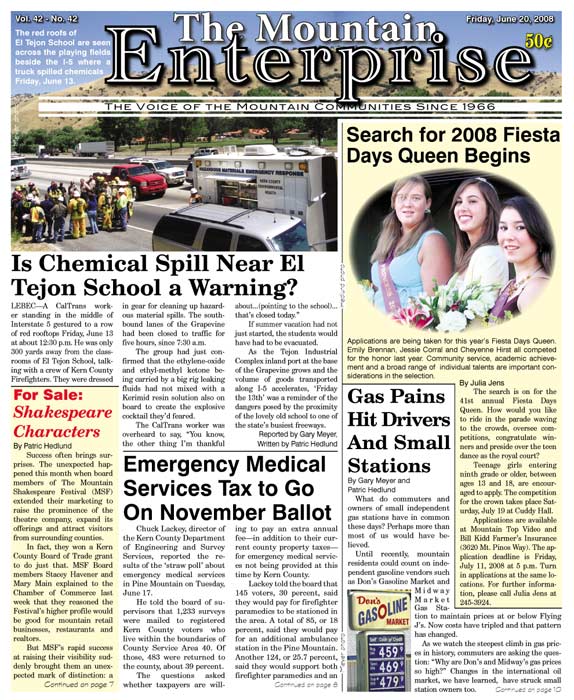![Local independent stations are finding it a challenge to compete among the gas giants. [Meyer photos]](https://mountainenterprise.com/fds/images/story/fs_3084.jpg)
Local independent stations are finding it a challenge to compete among the gas giants. [Meyer photos]
By Gary Meyer and Patric Hedlund
What do commuters and owners of small independent gas stations have in common these days? Perhaps more than most of us would have believed.
Until recently, mountain residents could count on independent gasoline vendors such as Don’s Gasoline Market and Midway Market Gas Station to maintain prices at or below Flying J’s. Now costs have tripled and that pattern has changed.
As we watch the steepest climb in gas prices in history, commuters are asking the question: “Why are Don’s and Midway’s gas prices so high?” Changes in the international oil market, we have learned, have struck small station owners too.
Mountain commuters we have interviewed over the last two months are spending over $1,000 a month to get to work. Some are angry, assuming that independent mountain stations are making a fat profit.
Independent Stations
Mike Khalil, owner of Don’s Gasoline Market, said in an interview Tuesday, June 17 that independence—the quality that previously made it possible to deliver local gas at the best prices anywhere— is now a handicap.
Previously, while oil was in full supply on the international market, all companies could purchase oil shipments coming into the ports, including independent marketers, he said. “Now, when a ship comes into port, Chevron, Shell or ARCO takes that shipment. Independent markets can take a ship only if no one else wants it,” Khalil said.
“The names of large oil companies mean price protection for their stations. If the price jumps 15 cents, they can raise the price only five cents to their stations because they have a large supply. An ARCO station owner can call the company and say, ‘Our competitor across the street is selling at $4.43, so I need it at a lower price,’” Kahlil said. Independents don’t have that protection. They have no one to call. Neither do most commuters.
Commuters
Al Tapia, a postal worker commuting to Castaic six days a week, finds it hard to match his hours with other mountain commuters for ride sharing. In April he was paying over $100 a week for gas, and his is a relatively short commute. Now costs have almost doubled. He’s considered getting an RV to sleep off the hill to save costs.
Corporate travel specialist Teri Pierce drives from Frazier Park to Universal Studios, a 150 mile round trip each day that costs about $275 a week. She has to leave home at 6 a.m. to dodge traffic so she can be in the office by 9 a.m.
“When there is an accident it can take between three to four and a half hours to get home at night,” Pierce writes. “I never have time to eat dinner. I just come in and go straight to bed. For seven years I had jobs as far down as 20th Century Fox which put an extra 30 miles on. Last year I even took a job in Santa Barbara…that was 165 miles each way!”
Pierce fills up every night at Don’s Market and says that her housing costs on the mountain buy so much more quality than she could afford in the city that it is still worth it.
Mindy Moffatt of Pine Mountain teaches at a school in Ventura. She takes the commuters’ mileage championship, and still writes about it poetically: “It’s not a hard commute; it’s just long and beautiful. So I drive 195 miles every day, thankful that I live on The Hill.”
Carpool Hopefuls
Shirlene Barrington lives in Pinon Pines and drives to Bakersfield daily. She works at a law firm on California Avenue near Mervyn’s. “I have tried calling a few people who I think work down there, however, I haven’t had any luck. I am interested in seeing if car-pooling might be available. I work 8-5 but my hours may be adjustable,” she says.
Karen Barragan of Frazier Park writes that she is “more than willing to carpool or vanpool to Third Street and Alvarado in Los Angeles if anyone is interested.”
She has lived in Frazier Park for about 18 months. She drives to Los Angeles and her husband drives to Thousand Oaks. “When we decided to move here, I didn’t anticipate such issues to arise in regard to our commute,” she says. “Leaving my home at 5 a.m., it takes me about an hour or so to reach my L.A. office. Coming home is one to two hours minimum.
MetroLink
“I’ve tried the Metrolink from Santa Clarita,” Barragan reports. “However, I get to work later because I have to take the subway and then catch a bus to my office. Prices went up last year for the train, so between the cost of the train and the gas prices, I’ve been at a loss.” Has it been worth moving to Frazier Park? “Owning my own home, yes. But the commuting cost is nearly breaking us,” she said.
Vanpools
Some, like Karl Smith of Pine Mountain and Peter Bogdanoff of Pinon Pines are part of vanpools.
Bogdanoff rides the UCLA van which takes on additional riders whose destination is Los Angeles. He pays about $200 a month. The UCLA van is looking for additiona riders. Smith, a union welder, pays about $240 a month to ride in a van with Bakersfield welders working on the same construction job in downtown Los Angeles. T
Pundits
Pine Mountain resident Richard Reggio is retired and drives an electric cart locally, but he still spends almost $600 a month in gas to commute to the VA hospital in L.A. He believes the run-up in gas prices is all ‘hogwash.’ “There is no real gas shortage,” Reggio says, “The independents have the same access as everyone else.” He says there should be more controls on paper traders in petroleum futures. He says there is an “oil shortage scam to raise prices,” and mentions The O’Reilly Factor as his source.
Prices
On Tuesday, June 17 in Lebec, Flying J and ARCO were both charging $4.44 a gallon for regular (all prices rounded up). Shell and Chevron were $4.64. Midway and Don’s were both $4.60. The TA truck stop at the base of the Grapevine was selling the most expensive gas in the region, at $4.90 per gallon.
Khalil said he pays freight charges to have his gas delivered. Mainstream stations such as Flying J, Chevron, Shell and ARCO may not have to pay similar fees. Calls to Flying J were not returned by press time.
Lebec ARCO station owner Fred Matian says he is able to keep prices low because ARCO does not accept credit cards, only cash and debit cards. Instead of paying “a very large [credit card] fee per gallon,” he said, “we pass the savings on to customers.” Matian acknowledged that ARCO provides its stations with protection by adjusting prices in response to other stations.
“They survey the neighborhood every day. If another station lowers its prices, ARCO will adjust our price. But the only major competitor in our neighborhood is Flying J. The Shell and Chevron stations don’t compete with us,” Matian said, adding that Flying J is able to keep its prices down because they have their own refinery and haul their own gas.
At Don’s Market, Khalil says he is committed: “As soon as the price comes down, mountain residents will see my price also come down. I have always done that for my customers.”
This is part of the June 20, 2008 online edition of The Mountain Enterprise.
Have an opinion on this matter? We'd like to hear from you.


